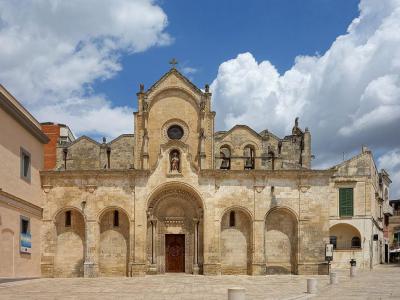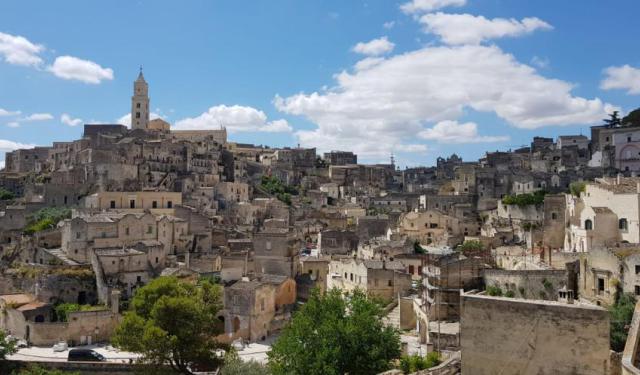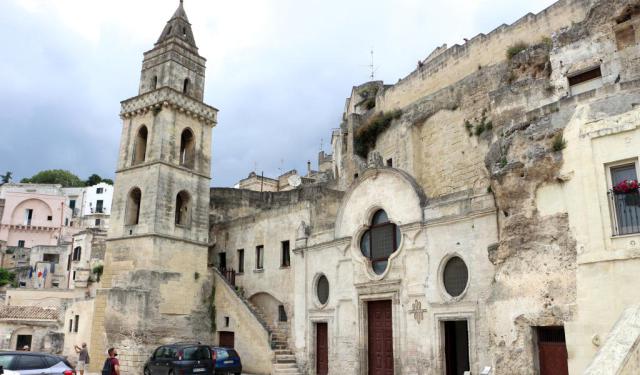
Chiesa di San Giovanni Battista (Church of San Giovanni Battista), Matera
In 1215, nuns of the "penitent" Order of Saint Mary of Acre landed in Matera from the Middle East. They received a chapel called Santa Maria la Nova, formerly a Benedictine facility. In 1229 they commenced work on a new church as a replacement. The replacement church was completed in 1236. It remained in use until 1480.
In 1480, the Ottomans made peace with Venice and sought to expand into southern Italy, starting with Otranto city. The nuns noticed that the church was outside the city walls and the Turks were coming. They abandoned their church.
In 1695 the Turks were long gone, and the archbishop of Matera transferred the parish of Saint John the Baptist to the abandoned 13th-century church outside the walls. The church of Saint Mary of Acre became the church of Saint John the Baptist (San Giovanni Battista).
In the 18th-century additions, the sacristy was added along with the Chapel of the Blessed Sacrament. The three domes over the transept were demolished and replaced with vaults. The facade has a gallery of five arches. The center arch is the tallest. It frames the 13th-century portal. A statue of Saint John the Baptist is above the door.
The basic plan is a Latin cross. A central nave is topped with geometric "Lecce vaults" ( a type of composite vault with a shape that resembles a star) flanked on either side with cross vaults. A multi-colored altar is on the left with frescoes of Santa Maria la Nova. In the Chapel of the Holy Sacrament are a painting and sculptures by Matera artists Vito Antonio Conversi and Altobello Persio.
In 1480, the Ottomans made peace with Venice and sought to expand into southern Italy, starting with Otranto city. The nuns noticed that the church was outside the city walls and the Turks were coming. They abandoned their church.
In 1695 the Turks were long gone, and the archbishop of Matera transferred the parish of Saint John the Baptist to the abandoned 13th-century church outside the walls. The church of Saint Mary of Acre became the church of Saint John the Baptist (San Giovanni Battista).
In the 18th-century additions, the sacristy was added along with the Chapel of the Blessed Sacrament. The three domes over the transept were demolished and replaced with vaults. The facade has a gallery of five arches. The center arch is the tallest. It frames the 13th-century portal. A statue of Saint John the Baptist is above the door.
The basic plan is a Latin cross. A central nave is topped with geometric "Lecce vaults" ( a type of composite vault with a shape that resembles a star) flanked on either side with cross vaults. A multi-colored altar is on the left with frescoes of Santa Maria la Nova. In the Chapel of the Holy Sacrament are a painting and sculptures by Matera artists Vito Antonio Conversi and Altobello Persio.
Want to visit this sight? Check out these Self-Guided Walking Tours in Matera. Alternatively, you can download the mobile app "GPSmyCity: Walks in 1K+ Cities" from Apple App Store or Google Play Store. The app turns your mobile device to a personal tour guide and it works offline, so no data plan is needed when traveling abroad.
Chiesa di San Giovanni Battista (Church of San Giovanni Battista) on Map
Sight Name: Chiesa di San Giovanni Battista (Church of San Giovanni Battista)
Sight Location: Matera, Italy (See walking tours in Matera)
Sight Type: Religious
Guide(s) Containing This Sight:
Sight Location: Matera, Italy (See walking tours in Matera)
Sight Type: Religious
Guide(s) Containing This Sight:
Walking Tours in Matera, Italy
Create Your Own Walk in Matera
Creating your own self-guided walk in Matera is easy and fun. Choose the city attractions that you want to see and a walk route map will be created just for you. You can even set your hotel as the start point of the walk.
Matera Introduction Walking Tour
Architectural historian Anne Parmly Toxey said the cave areas of Matera had been occupied for at least 3,000 years. There have been settlements in Matera since the Paleolithic era.
The town itself was founded in 251 BC by Roman consul Lucius Caecilius Metellus. He called it Matheola. Subsequently, the town was occupied by Longobards, Byzantines, Saracens, Swabians, Angevins, Aragonese, and... view more
Tour Duration: 2 Hour(s)
Travel Distance: 2.4 Km or 1.5 Miles
The town itself was founded in 251 BC by Roman consul Lucius Caecilius Metellus. He called it Matheola. Subsequently, the town was occupied by Longobards, Byzantines, Saracens, Swabians, Angevins, Aragonese, and... view more
Tour Duration: 2 Hour(s)
Travel Distance: 2.4 Km or 1.5 Miles
Matera's Ancient Cave Churches
Within the old city of Matera, there are more than 160 churches. Many of these are actually carved into the soft limestone cliffs lining the Gravina River. There are even some used for pagan rituals. The churches were carved from existing caves and tunnels. More than a few sanctified cave churches have been converted to storage and homes.
A good example to start with is the St. Anthony... view more
Tour Duration: 1 Hour(s)
Travel Distance: 1.7 Km or 1.1 Miles
A good example to start with is the St. Anthony... view more
Tour Duration: 1 Hour(s)
Travel Distance: 1.7 Km or 1.1 Miles


